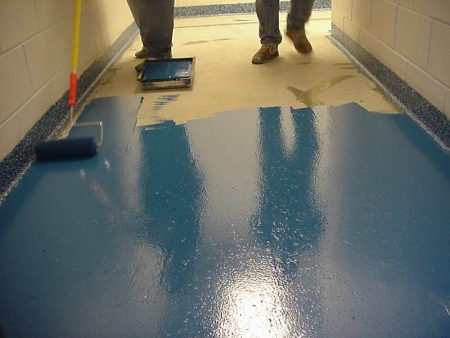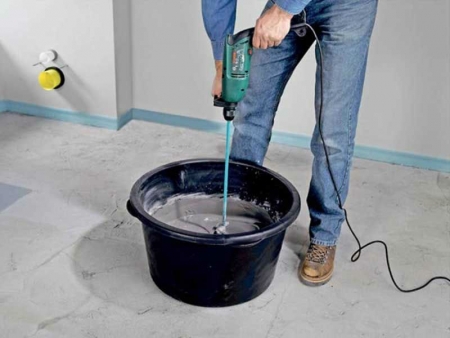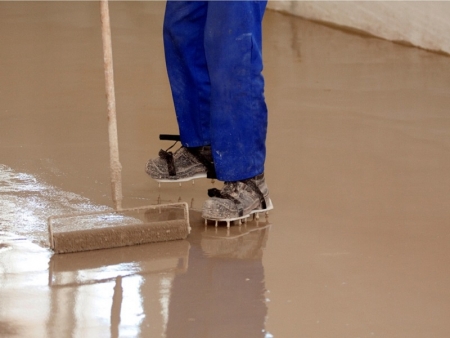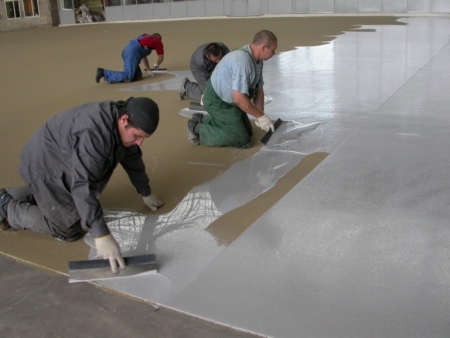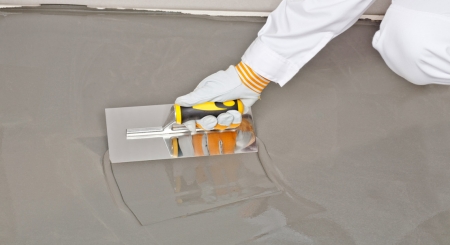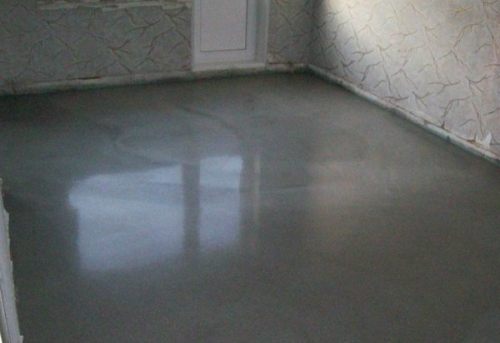In recent years, polycarbonate has received great distribution and popularity. Greenhouses ...
|
|
Overhaul is never complete without replacing the sewer system. But prices for ... |
The lock installed on the gate allows you to protect the residents of the house from a sudden ... |
Installation of bulk polymer floor with your own hands. Work on work
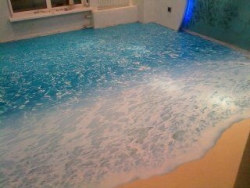
An important stage in construction or repair work is the implementation of high -quality flooring. Since it is on the floor that the largest load turns out, the requirements for the flooring are high. The construction market offers a large assortment of all kinds of materials, but bulk floors are becoming increasingly popular for both production space and private houses and apartments. They guarantee a long service life, while environmentally friendly, beautiful, moisture and impact-resistant. In the article, we consider the installation of a bulk polymer floor with your own hands.
Content:
- Polymer polyurethane coating on the floor
- Types of polyurethane floors
- Epoxy bulk floor
- Cement flooring
Initially, bulk floors were produced exclusively for places with large patency and high load, from here and their excellent strength characteristics. But thanks to the possibility of creating a variety of designs, they were increasingly using them in residential premises. Unique decor creation of 3D images, all kinds of patterns or paintings. It is allowed to use any image in the desired resolution, which is printed according to the principle of photo wallpaper and poured with a thin transparent epoxy layer. Thus, in the bathroom you can create a beach, and in the kitchen a green lawn. In addition to traditional drawings, even natural decor elements, for example, dry flowers, are poured under the transparent layer.
But there are a number of disadvantages that are inherent in most types of bulk floors:
- the technology of the process is laborious and long. To achieve the desired quality, you have to very carefully prepare the base. And with a direct filling of liquid composition, it is necessary to work in protective clothing so that nothing falls on the non -sewing floor;
- since the bulk floor is a material of synthetic origin, that is, the probability of losing color saturation under direct sunlight;
- if the design is tired over time, it will be difficult to dismantle the floor. But on top you can fill in a new layer of material of the desired shade;
- high final cost compared to other flooring.
In addition, bulk polymer floors need care, which will prevent premature aging and cracking of the coating. It consists in several simple rules:
- if possible, walk on it in stilettos or with a very dirty sole;
- prevent the presence of sand or any other abrasive substance on the bulk floor;
- use additional protective coating. Over time, all the cracks and scratches that appeared on it are easy to remove by polishing.
Polymer polyurethane coating on the floor
- This is not just a high -strength coating, but also safe, as it does not support combustion. That is why it is often recommended for filling floors in public places, as well as in residential and warehouse premises. And the ability to prevent the formation of mold and pathogenic fungi on it was made by polymer polyurethane floors in demand for catering units and public catering places.
- Polyurethane does not conduct current, which means it can be used as a flooring in boiler rooms and boiler rooms.
- Resistant to ultraviolet radiation and adverse weather conditions. By adding various collars to the composition, you can make a durable coating with markings for street play and sports grounds.
Types of polyurethane floors
One -component bulk floor
- This is a thin coating, the thickness of which does not exceed 4 mm. Apply it to only a perfectly prepared base.
- It is easy to apply it independently, so most often they are chosen for repair in apartments and private houses on their own. Such a floor withstands a low load and is resistant to washing with chemicals.
IMPORTANT: When moving furniture, traces may remain on it.
Two -component bulk floor
- Only professionals can make such a floor qualitatively. The finished coating withstands high mechanical loads. The thickness of the layer is 250 mm. In this connection, it is more often chosen for public places.
- I use a transparent mixture as the upper layer, you can create volumetric designs using a printed pattern or natural materials.
- With high intensity, the service life will be at least 15 years subject to the technological process. These advantages of bulk polymer sex play in his favor in choosing with a traditional concrete base.
Technology installation of bulk polymer sex
The process is performed manually and can be performed independently. All work is divided into three main stages:
- high -quality preparation of the base for filling;
- applying a primer for better adhesion;
- pouring polymer composition.
Preparatory work
- For uniform thickness of the bulk floor layer, even concrete coating is required for it. If it is, but of poor quality, you can try to align it.
- They use it for this sandbrown equipment. The sand is supplied under high pressure, which allows, as it were, to emphasize the surface, removing small irregularities. In addition, with such processing, the surface is made more porous, which increases its adhesive qualities.
- If such equipment is difficult to find, then you should use grinding machine With concrete discs. But after grinding, you need to carefully clean all the dust, which can harm the quality of the subsequent filling of the bulk floor.
Surfacing primer
- The primer is a liquid composition, so it can be applied in any convenient way: a roller, a brush or spray gun. The latter cannot be used if sand is added to the primer to make the surface more rough.
- It is necessary to primer at least 2 times, after waiting for the complete drying of the previous layer.
Equipment for bulk polymer sex
- Burning floors, as can be seen from the name, are always sold in liquid form. Each component goes in a separate bucket. Therefore, before starting work, you need to carefully read the manufacturer’s instructions on how to mix the composition correctly. But most often the main component is always larger and adds 3 parts to 1 part of the modifier.
- Due to the high viscosity of the composition, a screwdriver, a drill or a perforator with a nozzle, a mixer may not cope with stirring, it is better to prepare for work special mixer.
- The setting of a mixed solution occurs after an hour. It is important to mix as many solutions for the reception as it will be possible to lay and smooth during this time. To accelerate the process of leveling, you need to buy a special needle roller with a long handle, as well as shoes with studded sole, for walking through a freshly laid solution.
Polymer floor installation instructions
- The theoretical part of the process technology is quite simple.
- First, the mixture is poured onto the floor and leveled. Since the composition is liquid, it is quite quickly leveled. It remains only to roll it with a needle roller to remove air bubbles and better seal.
Polymer floor with your own hands photo
- If several layers are provided, each subsequent is carried out no earlier than a day after pouring the previous one. 24 hours after the finish work, you can already walk on the floor.
Epoxy bulk floor
The main advantages of bulk epoxy floor:
- epoxy bulk floors are a seamless glossy base. Lack of cracks, joints or pores prevents moisture stagnation and, as a result, mold formation;
- it is easy to care for it, it is allowed to wash with any detergent chemicals;
- for several decades, it will not lose its strength, will not be isolated and will not deteriorate even under the direct effect of sunlight;
- it does not have an unpleasant odor, the low price and the ability to fill it with your own hands without special skills makes it popular in repair work in apartments and houses.
Installation of bulk epoxy floor with your own hands
- If the base for the fill is in good condition, then it is enough to remove the garbage and dust and the cracks are thrown. With severe injuries or bumps, a thin layer of concrete screed will have to be poured.
- Since the bulk floor has the ability to self -interfere, a significant difference in height will lead to a large consumption of an expensive mixture. Therefore, in this case, it is also recommended to make a preliminary screed.
- The prepared base is primed with the addition of quartz sand 2-3 times.
- Next, you need to take care of materials and tools. In addition to the primer, in addition to the primer, the two -component composition of the bulk floor, the transparent polyurethane varnish and putty based on epoxide are necessary for pouring a bulk epoxy floor. From the tools you will need a mixer and a mixing bucket, spatula, rocket, needle roller.
Stages of work
- During work, the humidity in the room should not be more than 75% and temperature within 10-25C, and the temperature of materials is not lower than 18C.
- After priming, it is recommended to make a preliminary thin layer of 2 mm of a bulk floor. He will close the pores of the material and reduce the subsequent consumption of the composition. The mixture is mixed and left to brew for 3 minutes. Then poured to the floor and leveled with a spatula. The finished knead should be used very quickly, literally in 10-15 minutes.
- Then the composition is diluted from the consumption of 400ml/m2. It is poured and leveled. Particular attention is paid to areas around pipes, batteries, corners, etc. After 15 minutes, the entire surface is pierced with a needle roller.
- The floor will seize in a day, but it can only be used in a week. Throughout this time, it must be protected either by water and dirt, but at the same time not to close it.
- As an additional protection, polyurethane varnish is applied to the finished floor. You can walk along it only after four days.
Polymer Paul Walm
Cement flooring
It is used as a finish leveling layer of a traditional cement screed. This is an inexpensive type of bulk floor in which cement acts as the main astringent component. In addition, special polymer additives and sand are included in the composition.
Installation of a bulk cement floor with your own hands
- Preparation before pouring consists in harvesting garbage and removing dust from the floor and walls.
- After that, the laser level marks the pouring line around the entire perimeter of the walls. And the dampfer tape is attached to this height. It is made of insolon or polystyrene foam. Due to its foamed structure, it has the necessary elasticity, which will protect the floor from cracking during expansion. It is allowed that it can be slightly higher than the level of future sex, as it will still be disguised by skirting boards.
- Then the entire flooded surface is treated with a primer with any convenient method. Cracks and recesses are especially carefully smeared. If the base is new, then it is enough to disagree once, but they are old, crumbles and has irregularities, then the procedure is repeated at least 2 times. Each time, taking a break until each layer dries completely. Depending on humidity in the room, it takes from 7 hours to a day.
- Further, as in the case of a traditional cement screed, lighthouses are exhibited. They put them just below the level of the finished floor (leaving a place for the leveling upper layer). Be sure to check horizontal evenness with a level.
- Pour the solution, level the beacons and leave until completely harden.
- Now the turn of the leveling layer has come. It is quite thin, so the screed under it should be as flat as possible.
- The bulk cement floor is sold in the form of a finished dry mixture and it remains only to mix it with water in accordance with the instructions on the package. First, the required amount of water is poured into the bucket, and then, stirring with a construction mixer, gently pour out the mixture, without ceasing to interfere.
- When a homogeneous consistency is reached, the composition is left for 10-15 minutes, and then mixed again. You need to work at low speeds.
- Then you will have to work quickly. It takes only half an hour to fill the floor (or a separate segment, which was originally divided into), then the solution is already starting to grasp.
- The solution is liquid, so it is easily poured and leveled with a roller with a long handle. It is recommended to perform work together or three.
- As final work, the entire surface passes with a needle roller. It will not only remove all the remaining air bubbles, but also improve the adhesion of the bulk floor with the base.
- If you need to go through a freshly -poured floor to another area, then this can only be done in special shoes with a needle sole. Full stagnation of the mixture occurs in different ways, on average it is 5-8 hours.



